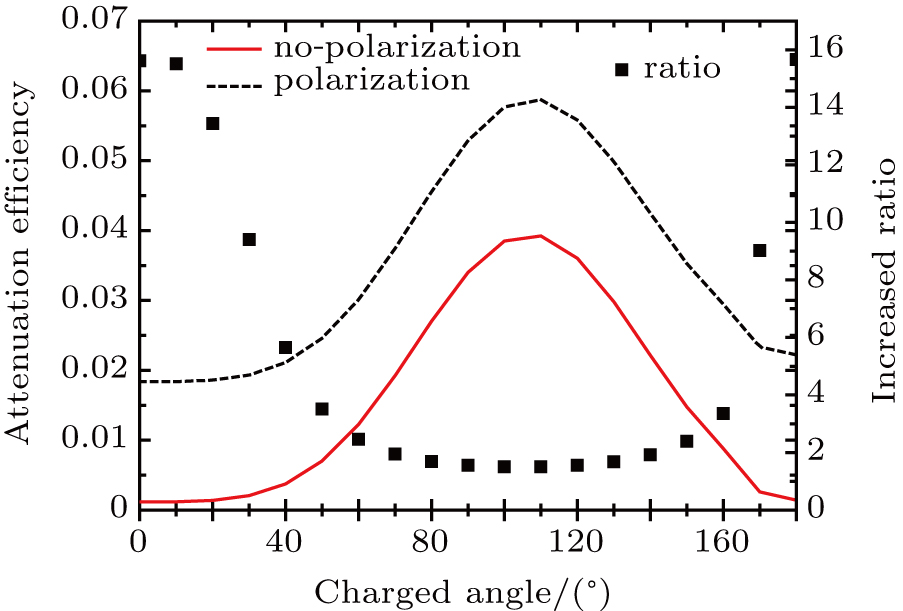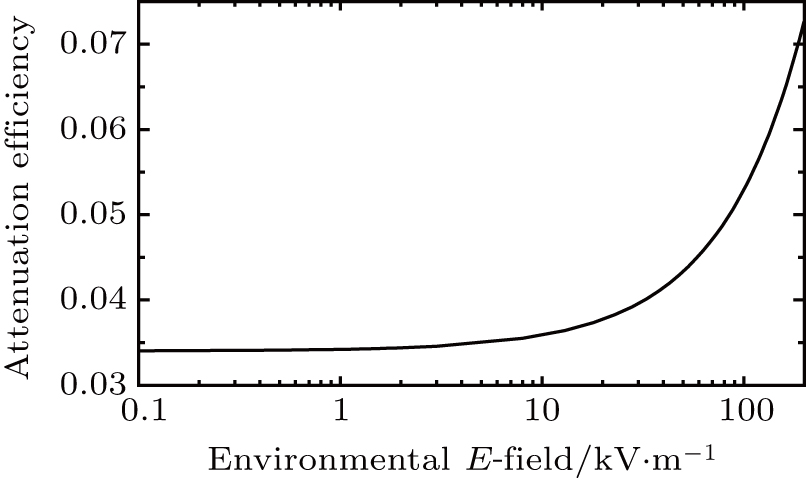2.1. The polarization chargeAs shown in Fig. 1, a partially charged spherical sand is immersed in an electric field of wind-blown sand. In this paper, we suppose that the particle radius is R and the permittivity is ε1. The surplus charge partially distributes on the particle, and the charge density is σ0, which uniformly distributes on a spherical cap of the sand, and the net charge distribution angle is 2θ0. The environmental medium is the air. The magnitude of the environmental electric field is Ep. Due to the electric polarization, the electric potentials inside and outside of the particle are ψ1 and ψ2, which can be expressed in the spherical coordinate as follows:[18]
Here
Pn(cos
θ) is the Legend function of the first kind, and
An,
Cn, and
Dn are the unknown expansion coefficients, which can be determined by the boundary conditions
Here
ε0 is the permittivity of the environmental medium, and
H(θ − θ0) is the Heaviside function.
[17] In this paper, we use a spherical polar coordinate system with coordinates (
r,
θ,
φ) and a rectangular coordinate system with coordinates (
x,
y,
z), the corresponding unit base vectors are

and

, respectively.
Through Eqs. (1)–(4) and set εr = ε1/ε0, we can obtain the potential functions as follows:
The inner electric field of the charged particle is
Then based on the equation
P =
ε0 (ε
r −1)
Ein and

, we can obtain the expression of the polarization charge
[26]
Considering the net charge on the particle surface is
σ0 which partially distributes on a cap of the sphere, the total charge on the particle is
σ =
σ0H(θ − (π − θ0)) +
σp. In the next section, we will set it as a constant for every
θ.
2.2. The extended Mie theory for partially charged sphereSuppose that the incident wave is a z propagating plane wave characterized by the wave vector
 , where k = 2π/λ is the wave number, and λ is the wavelength. The electric field vector of the incident wave is Einc = E0 exp (ikz)x. The electromagnetic field of the incident wave can be expanded as follows:[27]
, where k = 2π/λ is the wave number, and λ is the wavelength. The electric field vector of the incident wave is Einc = E0 exp (ikz)x. The electromagnetic field of the incident wave can be expanded as follows:[27]
where
ρ =
kr,

and

are the vector spherical harmonics functions, and can be represented as follows:
Here

is the associated Legend function of the first kind, and for the function
zn (
ρ) in

and

, if
j = 1, the function
zn (
ρ) is the spherical Bessel function of the first kind, named as
jn (
ρ), if
j = 2, the function
zn (
ρ) is the spherical Bessel function of the second kind, named as
yn(
ρ), and if
j = 3, the function
zn (
ρ) is the spherical Bessel function of the third kind, named as

, with i being the imaginary unit. Then the interior field and the scattering field can also be written in the similar forms
The unknown coefficients can be determined by the boundary conditions
[19,21]
Here
σs is the surface conductivity, which can be obtained through the equation
σs(
σ) = i σ
q/[
m(
ω + i
rs)], and

,
σ is the surface charge density which can be derived from
σ =
σ0 H(θ − (π − θ0)) +
σp present in the last section.
m,
q, and
r are the mass, charge, and radius of the electron, respectively,
N is the electron number, and
T is the surface temperature.
In principle, the electric polarization means that the positive charge in the material moves along the direction of the applied electric field, and the negative charge (usually, electrons) is reversed moving, thus one half of the particle surface is positively charged, the other half is negatively charged. For the nuclei, it is too large to produce a surface current with the action of the incident electromagnetic wave, but the electron can. So the valid charge which may contribute to the surface conductivity is just the negative ion (σp < 0). This means that the surface conductivity in Eq. (15) can be expressed as two parts, one is from the net charge, which can be calculated through σs(σ0H(θ − (π − θ0))), and the other one is from the polarization, which can be calculated from σs(σp H(θ − π/2). Here we have set σ0 as the net charge on the particle surface, σp as the polarization charge in Eq. (9), where H(x) is the Heaviside function.
Then through Eqs. (9)–(15) we can obtain
Through the above equations, we can obtain the expansion coefficients in Eqs. (
9)–(
14).
Then the particle’s extinction cross section can be obtained as
where subscripts i and s represent the incident field and the scattering field, and subscripts
θ and
φ represent the components of the field. The extinction cross section can be normalized by the particles' geometric cross section, and then we can obtain the efficiency factor
In the next section, we will use Eqs. (
16)–(
18) to discuss the electromagnetic scattering properties of the partially charged particle in a strong electric field.





































